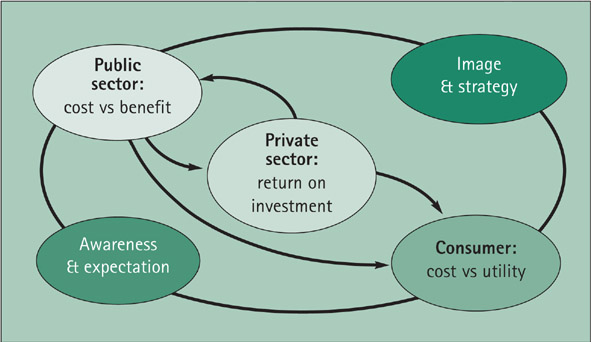
Road Network Operations
& Intelligent Transport Systems
A guide for practitioners!

Road Network Operations
& Intelligent Transport Systems
A guide for practitioners!
ITS covers a wide range of systems and services. Different stakeholders are involved - and their roles and attitudes, as well as legal and institutional issues - vary in each ITS deployment. Whilst there will be wide variations between different applications and individual institutions - three broad groups of stakeholders investing in ITS can be distinguished:
1) Users and consumers of ITS (corporate or individual): require systems and services that meet their real needs. They have high expectations of service quality, reliability and availability (dissemination channels). The willingness to pay for ITS systems and services strongly depends on the actual and perceived utility of the service as well as on its image. The acceptable price may not correspond to the actual costs of service generation and delivery
2) The public sector: will adopt ITS to deliver various public services, objectives and strategies. Where these are made explicit - public interests in ITS service development are usually justified by positive impacts on traffic management and modal shift, road safety, sustainability, economic development, business location, image and social inclusion. Public authorities then seek to involve the private sector so as to mobilise the enterprise culture, limit public expenditures and increase efficiency
3) The private sector: share the objectives of marketing their products/services through ITS, entering a future growth market - and/or developing a new profitable business area. In this, the private sector depends heavily on the framework conditions established by the public sector - which they soemtimes perceive as an obstacle to the free market. On the other hand, differences between various private sector stakeholders leads to different orientations and priorities when defining new ITS service delivery models. These differences need to be recognised in the strategic agreements with the public sector.
Three very different business model evaluation systems come into play - as these groups consider whether to allocate their budgets to ITS.
1) The consumer (any individual or organisation that is the end user of an ITS system or service) evaluates the utility of ITS in relation to the buy-in cost and any recurring fees and charges that have to be aid.
2) The public sector usually has to justify investment in ITS on the basis of public service criteria or the benefits to the community - including affordability of the initial capital spend and any maintenance and long-term operating costs. There are several alternative evaluation methods (See Project Appraisal and Monitoring and Evaluation).
3) The private sector is concerned with the forecast return on the investment needed to bring ITS equipment, products and services to market - and the extent and reliability of any revenue streams
The interactions between these very different requirements are shown schematically below. ITS projects will frequently require justification against at least two, if not all three of the underlying business models. Failure to meet one or other of the investment tests will produce a classic “chicken and egg situation” – who goes first, the supplier or the purchaser in making a commitment to the system or product? Experience shows that this dilemma has been resolved in countries like USA and Japan by the public and private sectors jointly developing a strategic plan - including an ITS architecture that clearly defines the institutional responsibilities. When starting up cooperative system deployment in Europe - the Amsterdam group (See Amsterdam Group) consisting of vehicle manufacturers, road authorities, cities and private road operators - agreed on a road map with specific milestones reinforced by a common Letter of Intent signed by all, and a dedicated Memoranda of Understanding between the relevant local, regional and national stakeholders involved in different local deployments.
